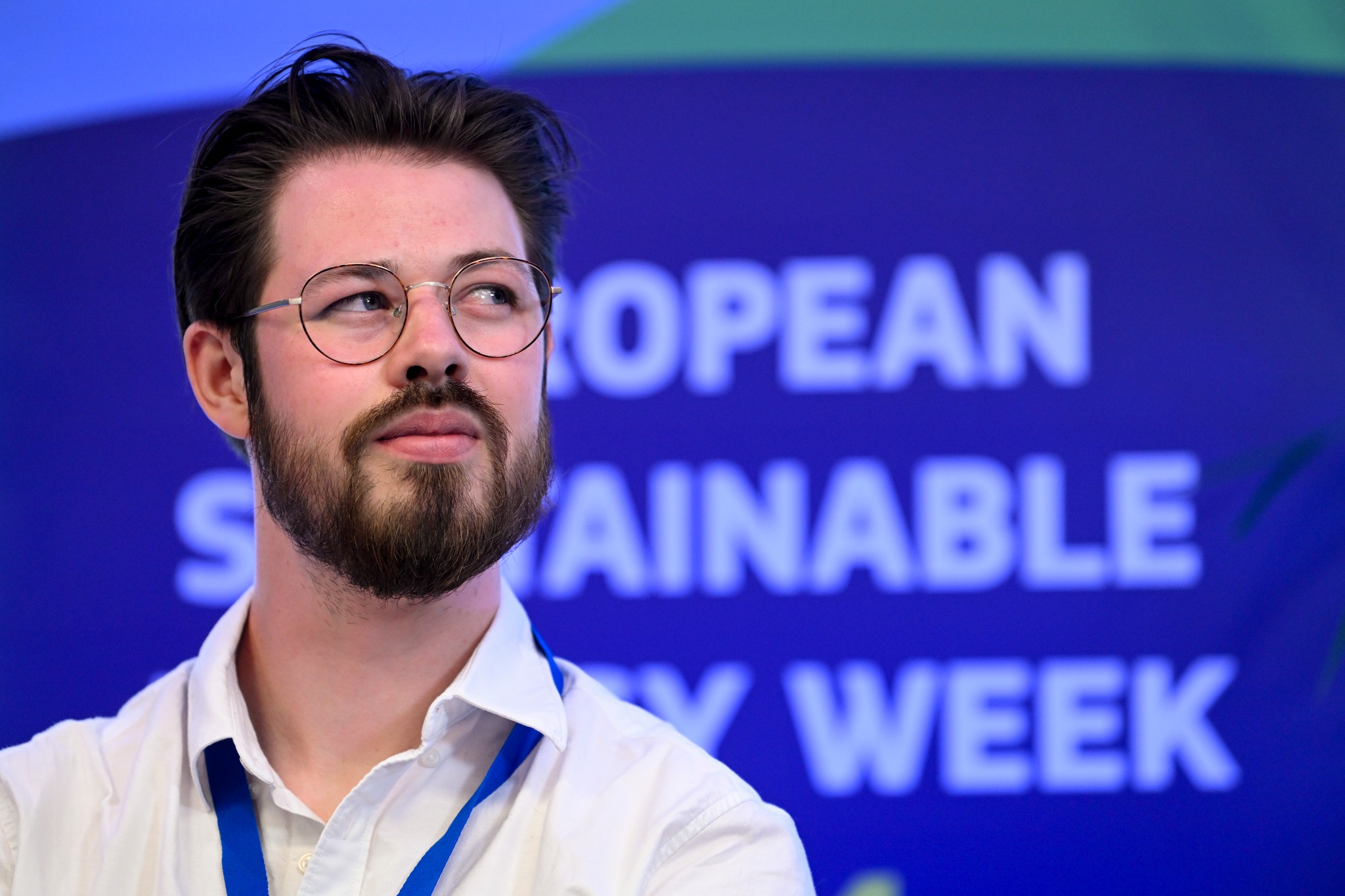At this year's EU Sustainable Energy Week (EUSEW) the Smart Cities Marketplace organised a dynamic pitch session that captivated a diverse audience of public institutions and stakeholders. Moderated by Tatiana Pasquel Garcia (Vito & Smart Cities Marketplace), the session highlighted five innovative and replicable solutions from across Europe, aimed at empowering communities, reshaping urban landscapes, and driving towards net-zero energy emissions.
The full house attendance underscored the significant interest and urgency surrounding sustainable energy solutions. Attendees participated in lively discussions and engaged with the detailed presentations provided by each speaker.
Amsterdam's Retrofit Revolution
Hessel Van Der Hoorn, an adviser for sustainability at Eigen Haard, presented the ambitious efforts in Amsterdam, Netherlands. The Eigen Haard Housing Corporation is undertaking a large-scale retrofit of over 900 housing units to transform them into nearly zero-energy buildings. Van Der Hoorn outlined the project's challenges, such as the complex stakeholder environment including both tenants and owners, and the urgent need for action amidst limited funding. He detailed how the national loan scheme and a lucky subsidy helped bridge a critical €10 million gap, enabling the project to become reality. The project's success hinged on stakeholder flexibility and clear decision-making processes, paving the way for future initiatives to eliminate gas usage and incorporate photovoltaic (PV) systems and heat pumps.
Efficient Heat Network Planning in Poznan
In Poznan, Poland, the THERMOS project is revolutionising heat network planning. Lewis McNamee from the Centre for Sustainable Energy detailed how THERMOS provides a user-friendly, cost-effective, open-source software tool for pre-feasibility studies. This tool helps cities like Poznan decarbonise and expand their district heating networks. With Veolia serving 60% of the city's population using fossil resources, the municipality explored various scenarios, including geothermal energy, heat pumps and waste heat from a Volkswagen factory. McNamee emphasised that these scenarios offer economic returns and significantly contribute to decarbonisation efforts. The success of THERMOS in Poznan is seen as a model for other cities, such as Zelzate, Secovce, and London.

Reykjavik's Green Mobility Hubs
Sylva Lam, Project Manager for International Climate Projects at the Mayor’s Office in Reykjavik, Iceland, presented the SPARCS project. This initiative focuses on reducing peak electricity loads and investing in green housing and mobility infrastructure. Reykjavik is capitalising on its abundant geothermal energy, making most of its energy consumption sustainable. However, Lam pointed out that mobility remains a significant source of greenhouse gas emissions. While 72% of trips is currently by private car, a survey pointed out that more than 60% of the respondents would prefer to commute in a more sustainable way. The city's solution involves developing multi-modal mobility hubs, with the Hlemmur hub being the first in Iceland. These hubs are part of a broader strategy to reduce car dependency, as evidenced by the city’s long-term transport plan, which includes relocating bus stops and changing road layouts to improve public transport and reduce car usage. As the infrastructure works interfere heavily with people’s daily lives, it is important to have good communication strategies and stakeholder processes in place.

AI-Driven Public Transport Optimisation in Bergen
Johan C. Haveland, CEO and Founder of Asistobe, shared insights from Bergen, Norway. Asistobe’s AI platform helps cities optimise public transport systems by analysing real transport demand. Haveland, who previously oversaw public transport in Bergen, highlighted the inefficiencies of traditional surveys and the need for data-driven approaches. By leveraging multiple data sources, Asistobe creates a comprehensive mobility picture that helps cities make informed decisions. In Bergen, informed planning led to significant infrastructure savings and increased public transport usage. The platform’s success in other cities like Bucharest, where it reduced the required public transport budget by 50%, underscores its potential for widespread application.
Hydrogen-Powered Electric Vehicles in Venice
Francesco Guaraldi from Agenzia per l’Energia e lo Sviluppo Sostenibile (AESS) discussed the H2GO project in the Venice area, Italy. The project addresses the limited battery capacity of utility electric vehicles by converting them to hydrogen battery electric vehicles. Guaraldi explained how a hydrogen refilling station in Mestre and retrofitted vehicles have increased the range and user confidence in hydrogen technology. A higher range per vehicle also allows to reduce the number of vehicles in the fleet. Despite the high cost of the filling station, the pilot project's success demonstrates the feasibility and benefits of hydrogen vehicles, with plans to expand the initiative further.
Key Takeaways and Future Directions
The session wrapped up with a focus on critical themes such as planning, stakeholder engagement, and communication. Hessel Van Der Hoorn emphasised the need for clear processes and flexibility among stakeholders. Lewis McNamee highlighted the importance of presenting economic cases effectively to different audiences. Sylva Lam discussed the broader impacts of mobility solutions beyond infrastructure, stressing the need for effective communication strategies. Johan C. Haveland called for better tools to understand and meet public transport demand. Francesco Guaraldi pointed out the importance of demonstrating the benefits of new technologies to gain user acceptance.
The discussions underscored the importance of public-private partnerships (PPP) and the collective effort required to drive sustainable urban transformation. The session concluded with a resounding call to make public transport more efficient and appealing, aligning with the overarching goal of creating sustainable, energy-efficient urban environments across Europe.

